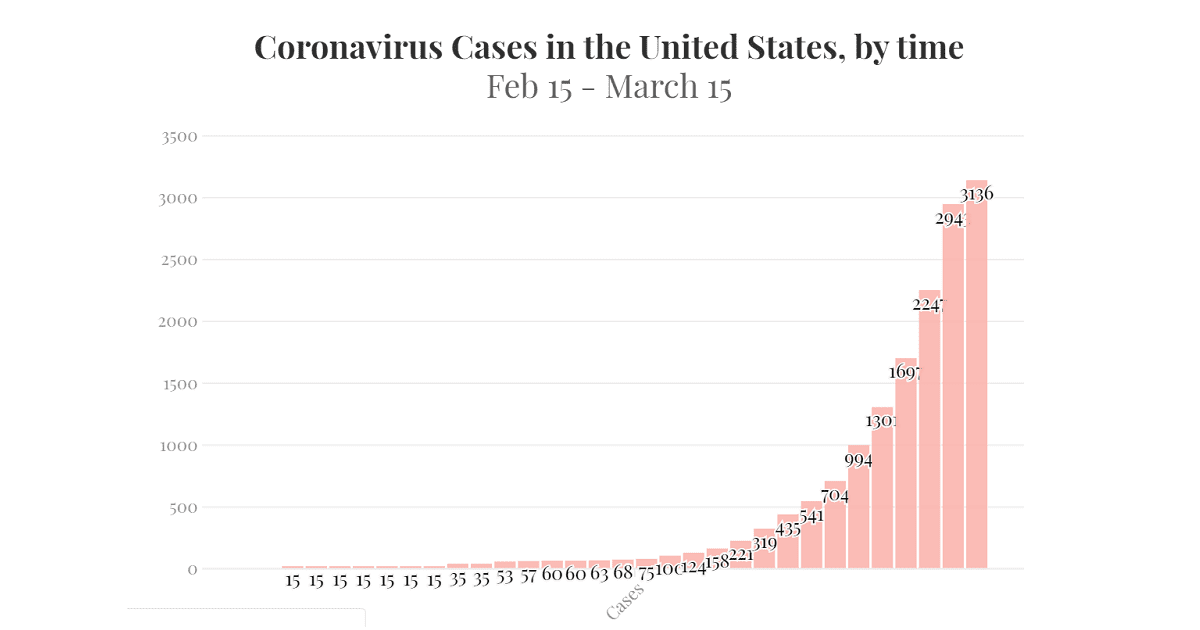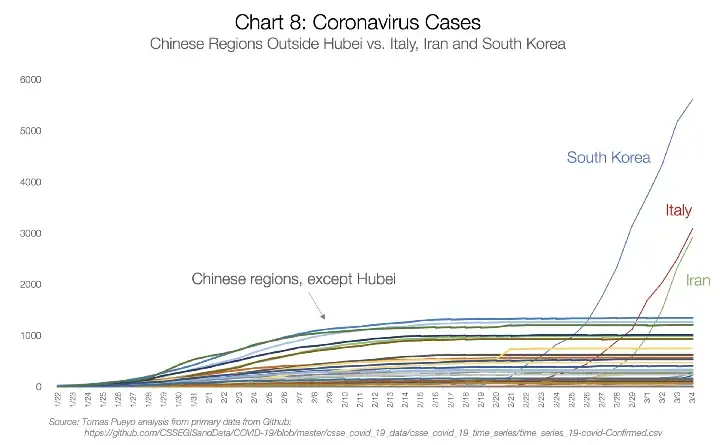COVID-19: Why America May Be Hit Hard for 3-4 Months & What To Do

Updated March 20 with new US cases by time and predictions based on 5 countries.
It’s here. COVID-19 hit China, Europe, and is grinding America to a halt. On March 13, President Trump declared a national emergency. Still, as a PhD in Public Health who specialised in epidemiology, I’m worried. Here’s why:
- The virus is spreading quickly
- It’s 10-40 times more deadly than regular flu (3.7% of people infected worldwide have died)
- 16% of people infected get “seriously ill” (Guan et al. 2020)
- In Italy, hospitals are overwhelmed (an intensivist said “patients above 65 are not even assessed”—they’re forced to let them die).
- US Centers for Disease Control projected “200,000 to 1.7 million people dying” and 2.4 to 21 million requiring hospitalization—but the country only has 924,107 staffed beds
- Based on 5 other countries, it looks like the virus will be around for at least 3-4 months
Symptoms:
- Fever
- Cough
- Difficulty breathing
- Pneumonia in both lungs
- Death (in severe cases)
You are more at risk if:
- You’re male
- Over 65
- You have a compromised immune system (Health Canada)
- You have a condition (heart or respiratory disease, diabetes, hypertention, or cancer)
Symptoms can take up to 14 days to appear. You can transmit the virus even if you have no symptoms (Bai et al. 2020), and possibly 1-2 weeks after symptoms (Woelfel et al. 2020, preprint data). In Massachussets, a cluster of 82 people have been infected by people with no symptoms.
“It is a failing, let's admit it.”
This is Dr. Anthony Fauci from the National Institute of Allergy and Infectious Diseases, at a congressional hearing. “The idea of anybody getting [tested] easily, the way people in other countries are doing it, we're not set up for that.”
Americans are not getting tested. As of March 12, The Atlantic estimates that about 8,000 people have been tested in the US. Compare that to 29,700 in the UK and 210,000 in South Korea, and you can see why the number of confirmed cases in the US is suspiciously low.
In fact, in many states, testing rules are so strict that doctors may not notice a community outbreak until it’s too late.
“It has probably bought us a few hours, maybe a day or two”
This is Tomás Pueyo, on the US administration’s ban on European travel, in an in-depth analysis viewed 28 million times on Medium. When people don’t interact with each other, the virus doesn’t spread. You can see it in the following chart: Chinese regions (except Hubei) contained the outbreak with lockdowns, whereas South Korea, Italy, and Iran reacted late and saw it spread.
(Source)
Taiwan (right next to China) acted early. They got only 50 cases out of 23 million people by isolating them (Want et al. 2020).
So the travel ban makes sense. But with so many untested and undetected cases, it’s probably coming in too late. See the lines curving up for South Korea, Italy, and Iran? I’m afraid this is what’s coming for the US. But it may not be too late to flatten the curve.
Flatten the curve
You can slow down the outbreak by keeping your distance. In Italy, the town of Lodi had the first case, and locked down on Feb 23. Bergamo waited until March 8. See the difference:
Other countries suggest outbreak will last 3-4 months
Total cases in Italy, UK, and Iran have been going up for 1 month (see above). South Korea, with great measures in place, has just stabilised after 1 month. The US, arguably, has bad measures in place. So I estimate 1-2 months of total cases going up.
Next, people infected start to recover, or die (1-7%). But new people get infected, so the curve becomes flat. The curve was stable for 1-2 weeks in South Korea and China, with good measures in place.
Then most people have been exposed. You either got it, didn’t get it, got sick and recovered, or you’re dead. So cases go down. Active cases in China have been going down for 1 month. But people are still dying, and have another 2-3 weeks to go.
Based on the above, I predict 3-4 months total. Still, it’s not too late to slow down the outbreak, and avoid overburdening hospitals. What can you do?
Stay home
The best way to stop the outbreak is to stay home. It worked in China (see lockdowns above). In fact, according to the World Health Organization, even if you have mild respiratory symptoms, you should stay home. Here are more tips from the Organization:
To recap:
- Wash your hands often (e.g. when you get home, before you eat, after using the restroom)
- Wash your hands at least 20 seconds (with soap or a rub with at least 60% alcohol)
- Avoid touching your eyes, nose and mouth
- Cover your mouth and nose with your bent elbow when you cough
- Maintain at least 1 metre (3 feet) distance between yourself and anyone who is coughing or sneezing
- If you have a fever, cough and difficulty breathing, seek medical attention and call in advance. Follow the directions of your local health authority.
If you can, stay home. Tell your parents and friends to stay home. Especially those aged 65 and up (or with compromised immune systems or a medical condition), as the virus is more deadly to them. Be safe!
A note to athletes
I work with athletes. If you train, you should watch out for:
- Overtraining. This is when you train vigorously, yet performance deteriorates (Lakier Smith, 2003). You risk supressing your immune system, putting you at risk for upper respiratory tract infections (MacKinnon, 2000).
- Cutting weight. Hagmar et al. (2008) found that athletes striving for leanness reported being ill more often in the last 3 months. Tsai et al. (2011) found that taekwondo athletes who trained hard and cut weight before a national competition had suppressed mucosal immunity and more upper respiratory tract infections.
Concerned? It might be a good idea to ease off. What to do instead? Sleep, if you’re like the 1 in 3 Americans who don’t get enough sleep (CDC, 2016). Lack of sleep creates low-grade inflammation and weakens your immune system (Besedovsky et al. 2012). How long should you sleep? At least 7 hours a night (CDC, 2016).
Tell your US friends
Will 200,000 to 1.7 million Americans die, as the CDC experts projected? Not if we act in a big way. “There is a lot of room for improvement if we act appropriately”, said Lauren Gardner, an associate professor at the Johns Hopkins Whiting School of Engineering. So please share this article with your US friends. They need to understand and stay home. Act now, and we can avoid the worst.

